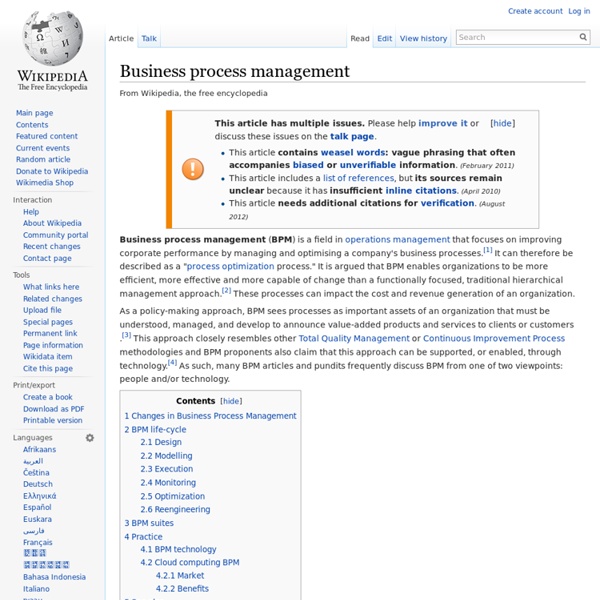Business process modeling
Business process modeling (BPM) in systems engineering is the activity of representing processes of an enterprise, so that the current process may be analyzed or improved. BPM is typically performed by business analysts, who provide expertise in the modeling discipline; by subject matter experts, who have specialized knowledge of the processes being modeled; or more commonly by a team comprising both. The business objective is often to increase process speed or reduce cycle time; to increase quality; or to reduce costs, such as labor, materials, scrap, or capital costs. In practice, a management decision to invest in business process modeling is often motivated by the need to document requirements for an information technology project. Change management programs are typically involved to put any improved business processes into practice. History[edit] BPM topics[edit] Business model[edit] A business model is a framework for creating economic, social, and/or other forms of value.
jBPM
jBPM is a flexible Business Process Management (BPM) Suite. It makes the bridge between business analysts and developers. Traditional BPM engines have a focus that is limited to non-technical people only. jBPM has a dual focus: it offers process management features in a way that both business users and developers like it. What does jBPM do? A business process allows you to model your business goals by describing the steps that need to be executed to achieve that goal and the order, using a flow chart. The core of jBPM is a light-weight, extensible workflow engine written in pure Java that allows you to execute business processes using the latest BPMN 2.0 specification. On top of the core engine, a lot of features and tools are offered to support business processes throughout their entire life cycle: BPM makes the bridge between business analysts, developers and end users, by offering process management features and tools in a way that both business users and developers like it. jBPM6
Architecture Organisationnelle
Office Support Systems Analysis and Design
Un article de Wikipédia, l'encyclopédie libre. La méthode OSSAD est une méthode d'analyse d'organisation par les processus. Cette méthode est le résultat d'un projet du programme ESPRIT (European Strategic Programme for Research in Information Technology) conduit de 1985 à 1990 par une équipe multinationale et multidisciplinaire de consultants. Le sigle OSSAD signifie : Office Support Systems Analysis and Design. OSSAD est strictement conforme aux exigences de modélisation de la norme ISO 9000:2000 qui recommande une représentation des organisations en trois strates : les Processus, les Procédures et les Instructions de travail. Modèles[modifier | modifier le code] Cette méthode s'appuie sur plusieurs modèles : Bibliographie[modifier | modifier le code] Jean-Loup CHAPPELET, Michael SHERWOOD-SMITH et al. : "The Office Process Redesign Language. Solutions[modifier | modifier le code] Ossad/process design. Références[modifier | modifier le code] Portail de l’informatique
Business Model Innovation Hub - ... where visionaries, game changers, and challengers discuss business models
Management Blog | FT.com
The end of management as we knew it Just a quick post to say that this is the last on the management blog. As Stefan predicted a few months ago, a new mantra of the modern world of work is to do “more with less”. Of course, that doesn’t mean the FT isn’t covering management, so please do keep an eye on Stefan’s column, our management page and for the latest news from the world’s business schools, go to our Business Education section or check out our very interesting MBA Blog, where students relay the joy – and the occasional trauma – of pursuing an MBA. Thanks for reading and keep your eyes open – the Management Blog may reappear in the future. Don’t ask business to save the world I always look forward to Michael Maccoby’s visits to London. Last week he was in town, and he told me about the senior corporate executive who had once said to him: “Don’t ask business to save the world.” What a way to run a country Business and politics rarely mix well, as I have noted here before.
Modélisation de processus métier
Un article de Wikipédia, l'encyclopédie libre. La modélisation de processus consiste à structurer et à représenter visuellement les activités de l'entreprise. Les modèles ainsi créés conduisent généralement à la création de logigrammes. Cette discipline utilise parfois l'acronyme BPM en référence au « Modélisation de procédure d'entreprise », mais cet usage tend à disparaître, car il peut être confondu avec le « Business Process Management (en) », dont la modélisation est une des activités. La distinction fondamentale entre ces deux notions de BPM réside dans le fait que pour la seconde, on s'intéresse à donner à l'entreprise les moyens de piloter et de maîtriser ses processus-métiers, tandis que la première ne consiste qu'à les modéliser (toujours avec un objectif venant de l'extérieur : optimisation de chaîne de production, expression de besoins fonctionnels pour un développement logiciel, ré-organisation suite à un rapprochement entre deux filiales d'une entreprise, par exemple).
Business Model Alchemist
Procédure d'entreprise
Un article de Wikipédia, l'encyclopédie libre. Une procédure est la manière spécifiée d'effectuer une activité ou un processus (ISO/DIS 9000). Elle représente la manière de mettre en œuvre tout ou partie d'un processus et est reproductible. Ainsi, pour un processus donné peuvent correspondre plusieurs procédures : la chaîne d'activités est identique, mais les ressources (applicatives, humaines...) utilisées pour son exécution peuvent varier (par exemple, d'une filiale à l'autre, ou d'une direction à l'autre). La procédure ne doit pas être confondue avec le mode opératoire qui décrit la manière d'effectuer une des tâches spécifiée dans la procédure. Définition [1][modifier | modifier le code] « Une procédure d’entreprise est une procédure qui systématise l’organisation et la politique d’une entreprise dans le but d’atteindre certains des objectifs de cette entreprise. » Exemples de procédures d'entreprise[modifier | modifier le code] Exemple d'application[modifier | modifier le code]



